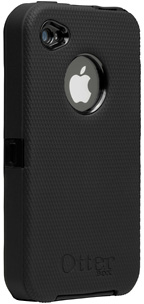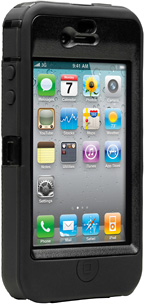Oh, the humanity. In my travels over the last few months, I have
witnessed firsthand dozens of nearly-new iPhone 4s in various states of
destruction.
Every one of them had one thing in common: It either had no case or
only had one of those minimalist cases designed solely for appearance.
In most instances, the damage was a cracked screen, cracked back glass,
or both - all easily preventable with the right case.
For the life of me, I can't figure out why someone would make a $600
or $700 investment and then fail to protect it with $49 worth of
insurance? In case you are scratching your head wondering exactly what
I am referring to when I mention a "$600 or $700 investment," I
reference that new iPhone 4 in your mitts.
"What?" you say, "I only paid $199 (or $299) for this iPhone!"
Did you really? Although you may have only parted with $199 at the
time of the transaction, your iPhone did not come with no strings
attached. You had to either enter into a two-year contract (if you were
not already an AT&T Wireless customer) or, if you were an existing
customer, extend your current contract for two more years.
If you are an existing customer, you are only eligible for the
subsidized (lower) pricing if you are eligible for an early upgrade. If
you are only a few months into your contract, you will have to pay the
unsubsidized (higher) price.
For instance, if you buy your new iPhone 4, stick it in your pocket
without a proper case, and then sit on it or bang your car door on it
and break it, then go to AT&T or Apple to replace it, they will
gladly sell you a new iPhone without any additional contract - for $599
or $699.
Protect Your Investment
 That $599/$699 expense could have been prevented with a $49
investment: the OtterBox Defender.
That $599/$699 expense could have been prevented with a $49
investment: the OtterBox Defender.
Those of you who follow Low End Mac regularly are well aware of my feelings
toward this line of cases. I don't feel comfortable using my iPhone or
iPod without one of these cases, much less taking either out of the
house.
The Defender case for the iPhone 4 improves on the previous model in
several areas.
The Defender offers 3 layers of protection:
- Layer 1: Clear protective membrane on screen
- Layer 2: Hi-impact polycarbonate shell
- Layer 3: Durable silicone skin
The first improvement I noticed right away was the new, redesigned
protective screen membrane. It goes on much easier than the ones
OtterBox (or any company for that matter) has produced in the past. The
new design virtually eliminates static and air bubbles. Even now, after
two months of use, the screen membrane has not developed that "oil
slick" appearance that is so common on screen protectors. It also
resists fingerprints much better than other models, with no noticeable
degradation of touch sensitivity.
The next step in installation is to place the iPhone into the heart
of the protective case system, the two-part high-impact polycarbonate
shell. The phone slides into the front half of the case, and then the
back snaps on. The inside of the shell is lined with felt, so no need
to worry about it scratching the iPhone.
 Once the two pieces are together, they don't come apart easily.
Depending on the length of your fingernails and the dexterity of your
fingers, a small screwdriver may be required to assist in lifting the
interlocking tabs if you ever desire to remove the iPhone from the case
(but why would you want to do that?). Finally, the polycarbonate shell
slips into the outer silicone skin for an added degree of "bounce"
protection.
Once the two pieces are together, they don't come apart easily.
Depending on the length of your fingernails and the dexterity of your
fingers, a small screwdriver may be required to assist in lifting the
interlocking tabs if you ever desire to remove the iPhone from the case
(but why would you want to do that?). Finally, the polycarbonate shell
slips into the outer silicone skin for an added degree of "bounce"
protection.
This outer silicone skin is ingeniously designed. There are multiple
small silicon tabs that slip into corresponding slots on the
polycarbonate shell, requiring a bit of time to install but ensuring a
secure fit and making the polycarbonate shell and silicone skin seem as
one after installation.
Keeps Dust Out
The best part is that all iPhone features are fully functional with
the case installed. Most of the ports are covered with flaps to keep
out dust and dirt when they are not in use. Clear protective layers
cover the Apple logo on the back of the iPhone, as well as the camera
(both front and back), flash, and proximity sensor. I have noticed no
degradation in camera image or flash quality with this case.
 I have also noticed that the Defender 4 does not seem to allow
dust into the case the way most other cases, including the Defender 3,
tend to. OtterBox has clearly invested a lot of time and research into
improving this next generation of the Defender series, with no detail
overlooked.
I have also noticed that the Defender 4 does not seem to allow
dust into the case the way most other cases, including the Defender 3,
tend to. OtterBox has clearly invested a lot of time and research into
improving this next generation of the Defender series, with no detail
overlooked.
Another area that received a complete makeover is the holster. The
holster was the Achilles' heel of the Defender case for iPhone 3G/3GS,
at least in the beginning. The phone was more likely to fall out than
not. Later redesigns improved the reliability greatly, but the case for
the Defender 4 takes security to a whole new level. I typically have to
use both hands to remove the iPhone from the holster, which is exactly
the type of secure grip a holster should have when protecting $600+
cargo. I no longer have any qualms about popping my phone in the
holster and going out and about. I know it will still be there when I
come home.
Unless your iPhone is permanently mounted to your desk and never
leaves the house or office, you will need this case someday. Better to
buy it now, before you regret waiting. By my calculation, you will have
saved at least $549.
The Defender for iPhone 4 is available in Black, Red, or Zircon Blue
with a MSRP of $49.95. Though it can be easy to forget with this sturdy
case in your hand, remember: the case is not waterproof!

Purchase Link
- Currently available from Amazon.com
in black for $29.99 with free shipping.

 That $599/$699 expense could have been prevented with a $49
investment: the OtterBox Defender.
That $599/$699 expense could have been prevented with a $49
investment: the OtterBox Defender. Once the two pieces are together, they don't come apart easily.
Depending on the length of your fingernails and the dexterity of your
fingers, a small screwdriver may be required to assist in lifting the
interlocking tabs if you ever desire to remove the iPhone from the case
(but why would you want to do that?). Finally, the polycarbonate shell
slips into the outer silicone skin for an added degree of "bounce"
protection.
Once the two pieces are together, they don't come apart easily.
Depending on the length of your fingernails and the dexterity of your
fingers, a small screwdriver may be required to assist in lifting the
interlocking tabs if you ever desire to remove the iPhone from the case
(but why would you want to do that?). Finally, the polycarbonate shell
slips into the outer silicone skin for an added degree of "bounce"
protection. I have also noticed that the Defender 4 does not seem to allow
dust into the case the way most other cases, including the Defender 3,
tend to. OtterBox has clearly invested a lot of time and research into
improving this next generation of the Defender series, with no detail
overlooked.
I have also noticed that the Defender 4 does not seem to allow
dust into the case the way most other cases, including the Defender 3,
tend to. OtterBox has clearly invested a lot of time and research into
improving this next generation of the Defender series, with no detail
overlooked.
